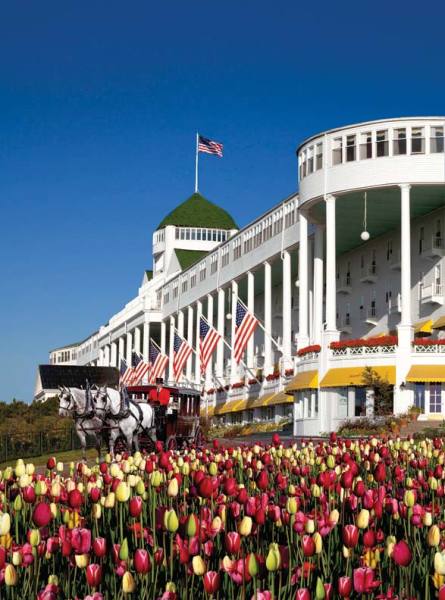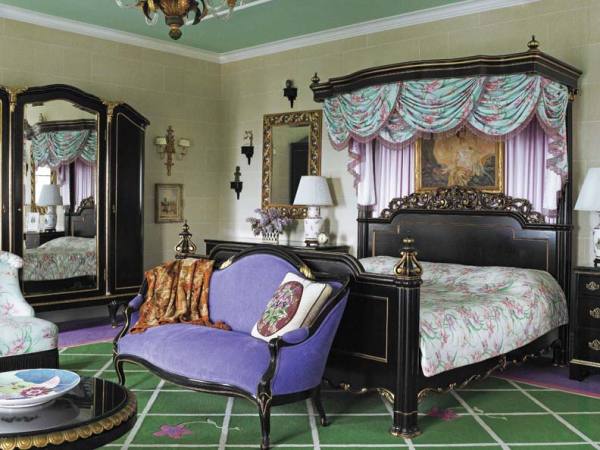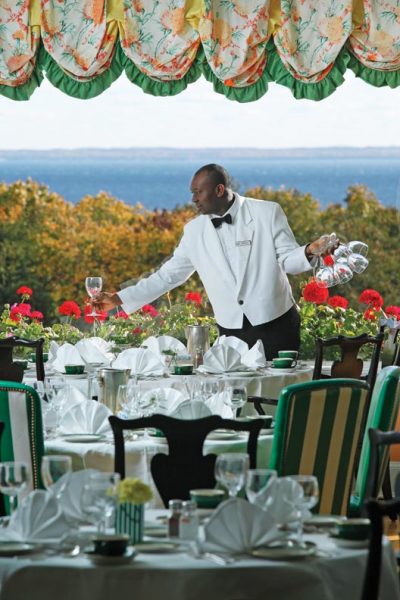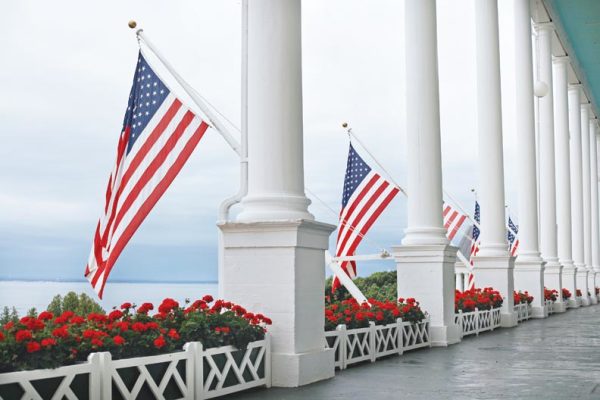
A vision in blooms awaits visitors, many of whom arrive by carriage.
Sitting in a vintage rocker on The Grand Hotel’s expansive, geranium-laden front porch—rumored to be the world’s longest—visitors are transported back in time. As the clip-clops of hooves from horse-drawn carriages in the hidden driveway below ring out like a metronome, and you’re met with an unobstructed view across the dusky blue waters of the Straits of Mackinac, it’s easy to imagine being here, immersed in the same sensory delights, some 125 years ago.
Back then, The Grand was new—an exotic destination hotel built by railroads to serve wealthy travelers from Detroit, St. Louis, and Chicago. By the early years of the 1900s, there were 1,200 such hotels across the country serving as oases for upscale Victorians fleeing the heat and pollution of summer in their post-industrialized cities. Today just a handful of these special wood-frame hotels remain; The Grand is the only one privately owned.
All in the Family
Since 1934, it’s been in the hands of one family, who have worked hard to sustain this all-wood hotel through the brutal winters that define northern Michigan. Current president Dan Musser III takes advantage of The Grand’s six-month winter shutdown to make any needed repairs. “I walk every guest room and make a detailed punch list,” Musser says. Being closed throughout the winter also saves on heating bills in a building created as a summer retreat, and requires a full draining of the pipes that feed the radiators and guest bathrooms—a task carried out with military-like precision each fall.
But doing repairs to plaster, paint, and wallpaper is a tricky business in the snap of winter, requiring the use of a custom-engineered electric food service cart. “Because the heat’s off, we must warm the rooms—and surrounding rooms—to 55 degrees in order for paint or wallpaper to stick,” Musser explains. The hotel retains 35 maintenance staff and 15 contractors for the inevitable touch-ups needed to keep this National Register grand dame in fine form.

Each of the 385 guest rooms is decorated differently; this upscale suite is named for the Vanderbilt family.
The first family member to helm the hotel was Dan’s great-uncle, William Stuart Woodfill, who arrived on the island to escape hay fever and fell so in love with the Victorian beauty that he asked the then-manager to give him a job—any job. “I’ll work for nothing,” he famously said. “Pay me at the end of summer what you think I’m worth.”
Woodfill went on to purchase the hotel in 1933. In 1951, he hired his nephew, R.D. (Dan) Musser, as a clerk—he worked nearly every job in the hotel before being named president in 1960, a job his son, Dan Musser III, took over in 1989 after stints in every department except the stables. Many credit the family’s vision, attention to detail, and constant presence (a member of the family is on-site virtually every day the hotel is open) with The Grand’s success. The hotel is a legendary destination throughout the Midwest (but especially among Michiganders), and today attracts guests from around the world.
Restoration Redux

The enormous dining room has views to the front porch—and beyond.
Like most expansive Victorian-era wooden buildings, this one has required some serious upkeep beyond the seasonal maintenance. In the late 1970s, Musser’s parents undertook extensive structural repairs on both the badly sloping east wing, which was made level, and the famous porch, which received concrete footings for the first time, along with steel pillars. At about the same time, the couple redecorated the interior, hiring Carleton Varney of Dorothy Draper & Company to outfit the place in a riot of color. None of the 385 guest rooms is exactly alike, adding an element of surprise around every turn.
The extravagant dining room gets an additional boost of drama from knee-to-ceiling windows onto the porch. It’s a great place for people-watching, from waiters expertly balancing huge trays of food and attending to every need, to guests arriving in their finest clothes, thanks to the dress code in effect since the late 1800s, and maintained by R.D. Musser. “My father used to say, ‘It doesn’t cost us a dime to make men put on a coat and tie at night, but it makes us look better,’” Musser explains. (Today, maître d’s expertly remove caps from men who forget to do so as they enter the restaurant.)
Other time travels include afternoon tea in the parlor, complete with musical accompaniment by either a piano or harp. Guests also can play croquet on the lawn—a tradition since the hotel’s opening.
Island Life
It’s hard to imagine how difficult it must have been to construct this building on a tiny (81⁄4 miles around), remote island in Lake Huron. Hotel historian Bob Tagatz explains that all of the materials—some 1.5 million board-feet of milled lumber—were pulled by horses over an ice bridge to the island. Tagatz once interviewed a woman whose grandfather helped with the dangerous task of transporting the lumber over the ice. “She told me nobody spoke, because they were too busy listening,” he says. “Every time a horse’s hoof fell they heard a crack—and wondered if it would be the big one that would take them to the bottom of the Straits.” It is beyond a miracle, Tagatz says, that nobody fell through the ice. The materials were transported over the winter of 1886, and the hotel was constructed in just 90 days the following spring, in order to open—on time—for the season on July 10, 1887.

The famous porch overlooks the Straits of Mackinac.
The island carries its own historical mystique. Cars were banned here in the late 19th century, for safety and health reasons, leaving horses and bicycles as the sole means of transport, which adds to the romantic feel. The hotel owns a fleet of antique carriages that ferry guests up a steep incline from the dock to the hotel, a location that affords unobstructed views from the 660′-long porch.
It’s easy to see why The Grand was selected as the setting for the 1980 movie Somewhere in Time, a love story featuring Christopher Reeve as a modern playwright who returns to 1912 to court an actress, played by Jane Seymour. The movie has proven so popular that it’s inspired themed weekends each October, with visitors dressing in period clothing and reenacting scenes from the film. It continues to draw visitors to this day. “Every time the movie replays, we see the reservation phones light up,” Musser says.
Movie fans or not, from the moment visitors catch their first glimpse of The Grand’s impressive slash of white architecture from the dock, they know they won’t soon forget it.
Online Exclusive: See historian Bob Tagatz’s list of other Victorian-era railroad hotels worth visiting.







